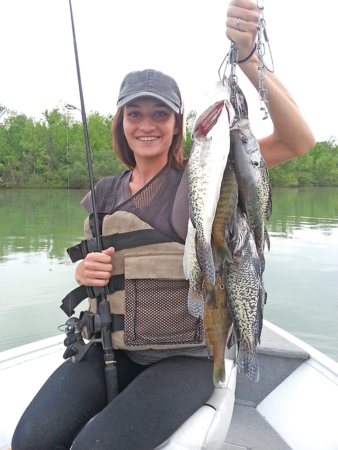This recent hot streak and lack of rain have put the damper on some fishing efforts; trout streams are very low, clear, and warm, making them less than ideal targets right now. Several people have commented to me that it’s too hot and muggy to do any kind of fishing — not so! Remember, I’m one of those strange birds who likes to go fishing in mid-January even when temperatures are in single digits and when temps go the other way, I still want to be on the water; I just change my targets and techniques.
Even now, in this mid-summer heat, it’s still not a bad time to pursue a number of different panfish. Lately, I have had several friends who are just getting into panfishing tell me they have had poor luck fishing in the same places where we had great success with crappies this past spring. That poor success rate is no doubt directly related to the fact that they were still fishing the shallows. Fishing water in the six-foot or less range might still be a good move if you are targeting bluegills and pumpkinseeds, but for other panfish like crappies and perch, it’s time to move deeper. You may also want to consider fishing earlier and later in the day or on overcast days.
Crappies are one of my prime mid-summer targets, and I will target lakes that I already know have reasonable crappie populations, suitable habitat, and deep enough water. In April and May, I was nailing those same crappies in wood and rock structures in water less than six feet, but now I’m drifting over 15 to 25 feet of water in search of crappies and perch. A depth finder or sonar unit is a very useful piece of equipment in this endeavor since it not only tells you the depth, but it also shows schools of fish that may be scattered up and down the water column. Bear in mind, it may tell you where the fish are in the water column, but you still have to be able to use the right tools to catch them, and sometimes that may not even work.
Generally speaking, I’m going to use ultralight spinning gear with a four-pound test fluorocarbon line; fluorocarbon has very low stretch making it more sensitive to strikes, and it’s nearly invisible. When I’m searching the depths for crappies and perch, I’m most likely using a lead head jig around one-eighth ounce and some type of soft plastic. I use white a lot, but there are times when other colors like brown, black, and even bright green will also produce. If things are slow, adding a lip-hooked small minnow, wax worm, or even a piece of garden worm may produce action, but generally, it’s not needed. Small spoons and small deep diving, lipped plugs, may also produce.
On occasion, you may also pick up some nice bluegills while fishing the deep water, but if I really want to target gills, I will more often than not move to shallower water and try working the surface with a fly-rod and small poppers. That’s not to say that other techniques won’t also produce; a tiny ice-fishing jig tipped with a wax worm or chunk of garden worm and allowed to rest a couple of feet beneath a small bobber would also be a good choice.
The point is, while the high temperatures may have put the hurts on some fishing, there is still a lot to be said for panfishing during these mid-summer warm spells. Who knows, if you can enjoy a day of catching panfish on a lake in 90-degree heat you may also be ready for a day on the ice-covered lake with temps in the single digits!





Leave a Comment
Your email address will not be published. Required fields are marked with *